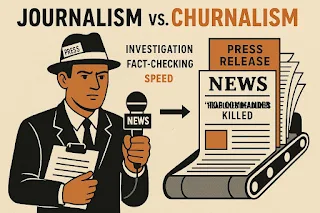In an age where information flows faster than ever, the line between journalism and churnalism has grown dangerously thin. As a journalist who began reporting from the rural belts of Jammu and Kashmir, I’ve seen firsthand how the integrity of news can either empower communities or leave them misinformed and voiceless.
What is Churnalism?
Churnalism is a term coined by BBC journalist Waseem Zakir and popularized by Nick Davies to describe a troubling trend in modern media — the regurgitation of pre-packaged content such as press releases, wire stories, or PR materials, without proper verification or editorial scrutiny. In other words, it’s when media outlets "churn" out stories not based on investigation, but on convenience.
Unlike traditional journalism, which demands digging, questioning, and verifying, churnalism is about speed, not depth. It sacrifices truth at the altar of clicks and deadlines.
Why Does Churnalism Exist?
Several forces have pushed journalism toward this hollow form. The collapse of traditional revenue models has left many newsrooms understaffed and underfunded. Reporters are now expected to produce more content in less time. In such an environment, press releases become ready-made “news” — published almost verbatim.
There’s also the pressure of social media and SEO. Headlines are crafted to trend, not to inform. The incentive isn’t accuracy — it’s virality. In this race for attention, real journalism often loses.
The Cost of Churnalism
The consequences are serious. When media platforms fail to question what they publish, they become mouthpieces — for corporations, governments, or anyone with a press release. Public trust in journalism erodes. Misinformation spreads unchecked. Critical issues get buried under superficial coverage.
We’ve seen this in many places, including Jammu and Kashmir, where sensitive stories demand scrutiny and care — not blind reproduction.
Major media claimed Altaf Lali was a "top LeT commander" killed after the Pahalgam attack.
— Anzer Ayoob | انظر ایوب (@AnzerAyoob) April 28, 2025
But their own first paragraphs admit he was only an "associate."
Indian Express reported that he was just the brother of a jailed militant, not a terrorist. 🧵 pic.twitter.com/k7onpKaFHp
In this tweet, I highlighted an example of churnalism, where major media outlets hastily labeled Altaf Lali as a "top LeT commander" killed in Bandipora, following the Pahalgam attack, without proper fact-checking. However, their own reports contradict this, admitting he was only an "associate" or, as the Indian Express clarified, merely the brother of a jailed militant—not a terrorist himself. This rushed narrative, driven by the pressure to publish quickly, fueled false perceptions and ignored the family’s claims of a fake encounter, which sparked protests in Bandipora. My aim was to expose how such unverified reporting in conflict zones like Jammu and Kashmir can distort the truth and demand a deeper investigation into Altaf’s killing on April 25, 2025.
Doing Journalism Right
When I started The Chenab Times, it was born from a desire to tell real stories from places the mainstream ignored. We publish in English, Urdu, Sarazi, and Bhaderwahi, because journalism must speak in the voice of the people it serves. We fact-check, we ask questions, and we believe that even a small, rural newsroom can stand against the tide of churnalism.
Local journalism, when done right, isn’t just a service — it’s a responsibility. It keeps power in check, gives voice to the unheard, and documents the truth when others ignore it.
The fight between journalism and churnalism isn’t just about media ethics — it’s about the future of public discourse. As readers, we must be mindful of what we consume and support news outlets that do the hard work of real reporting.
As a journalist, I remain committed to that purpose — to serve truth, not trend.









